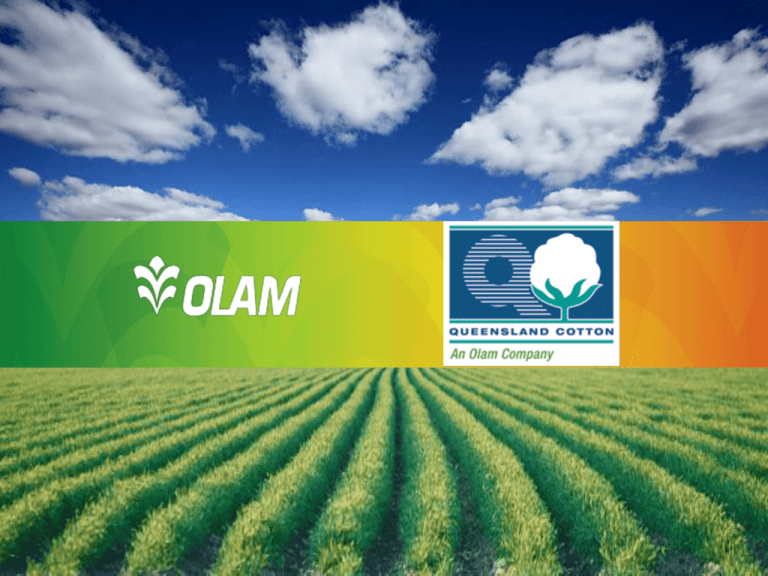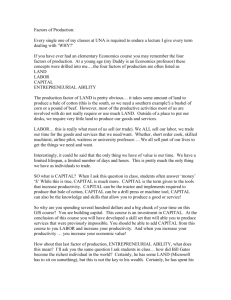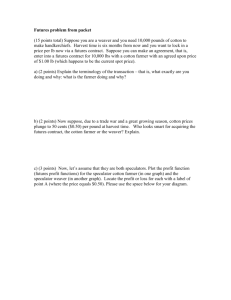E.Wegener-Brokering-Cotton
advertisement

Who is Olam? Olam is a leading global integrated supply chain manager and processor of agricultural products and food ingredients Presence across 16 platforms, 5 agricommodity segments across 4 value chain steps Cotton: #1 private ginner #2 merchant globally Over 18,000 employees operate in over 65 countries delivering to over 12,300 customers worldwide Olam is listed on the Singapore Stock Exchange In 2007 Olam purchased Qld Cotton 2 History of Olam 1989 Start-Up 1 product - Cashews 1 country - Nigeria 1 end Market 4 customers 2 employees S$0.15m Book Value S$0.15m Mkt. Value FY 2013 20 products 65 countries 50 end markets 12,300 customers 18,000 employees S$15.7 bn turnover S$444.6 mm PAT S$6.3 bn Mkt. Cap Sales CARG of 51% and PAT CAGR of 48% over the last 21 years Transitioned from a Trader to an Integrated Supply Chain Manager 3 Our Business: Supply Chain Manger of Agricultural Raw Materials Integrated from farm to factory gate ORIGIN CUSTOMER Managing Risk at Every Stage Farming Origination Logistics Processing Marketing Solutions & Services Trading & Distribution End-to-end Supply Chain Capability 4 Components of the cotton price Futures A$513 per bale Basis Exchange Rate 5 Futures Contracts A Futures contract is a contract between two parties to buy or sell a specific quantity and quality of a product at a given price for delivery at a specified time Futures contracts were originally used solely by producers and consumers for hedging. They are now also used for speculating by individuals and large companies 6 Futures Contracts 7 Impact on Cotton Price • Cotton Futures are the most volatile of the three components of the price and therefore needs to be the most closely monitored • Every cent movement in the Futures price will change the cotton price by approximately $5 per bale • The Australian $/bale price is calculated using the closing price of the May contract - if this is not available we use July or December 8 Basis • Basis is the difference between the cash price and the futures price. • It occurs due to differences between the product that the Futures contract represents and the worth of the product in the marketplace • This is a variable cost 9 Calculation of Basis Example: July 2014 Futures QC 2014 Cash Price 85.61 US cents/lb 90.36 US cents/lb 2014 Buy Basis = Cash price - Futures = 90.36 – 85.61 = 4.75 US cents/lb This is referred to as a basis of 475 pts ‘on’ 10 Relationship between Basis and Futures • A basis will generally strengthen (increase) on weaker NYF price • A strengthening of basis generally signals improving demand in the export market – this generally occurs in a weaker market • A basis will generally weaken (decrease) in a firm NYF price. This generally indicates a lack of demand in the export market. 11 Exchange Rate • The exchange rate is the value of one currency relative to another - eg 1 AUD equals 0.8915 USD • The exchange rate trades 24 hours a day starting the day in New Zealand and then moving to Australia, London and then New York • The exchange rate can be traded with all banks 12 Exchange Rate High @ 1.0545 (11th April 2013) Low @ 0.8684 (24th January 2014) Average @ 0.9548 V Today @ 0.8965 13 Calculation of Cotton Price Price = (Futures price +/- Basis ) x 500 lb/bale Exchange Rate = (0.8561 + 0.0475) x 500 lb/bale 0.8867 = A$510 / bale 14 Marketing Contract Types 1. Cash Fixed Bales • 1,000 bales @ AU$510/bale • 14 days after ginning payment OR • Call Pool payment (75% July/25% Dec) 2. On-Call Fixed Bales • 1,000 bales @ 90.65 US c/lb • FX to be fixed prior to FND • 14 days Payment OR Call Pool Payment 3. Balance of Crop • Flexibility regarding number of bales • Discounted from cash price 15 Managing Risk Price Production 16 Thank you! Elissa Wegener 0400 681146 Luke Chappel 0428 799 446 Meg Laidlaw 0427 816 315 17





